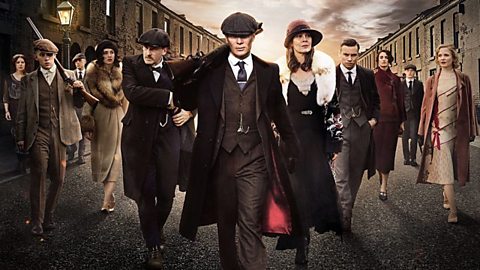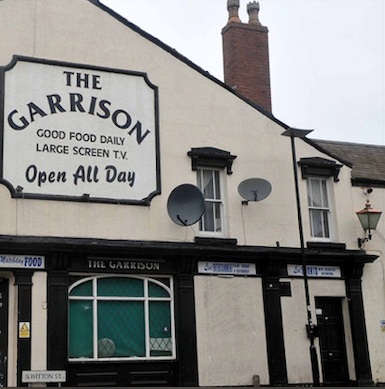
With the hit TV show Peaky Blinders now in its fifth series, it is clear that the British public certainly haven’t lost their appetite for gangster dramas.
The show has undoubtedly transformed the image of Birmingham, shifting the city’s undeserved reputation as a bland and boring commercial centre towards a notoriety previously enjoyed, at a time when it was proudly touted as the city of inventions and the natural homestead of Britain’s industrial revolution.
Why Birmingham?
Creator Steven Knight’s grandparents hailed from Small Heath, the area around which the drama is centred. His drama series attempts to recreate the angst and the violent antics of working class gang members operating in inner city Birmingham during the 1920s, against a backdrop of grimy backstreets, industrial smog, overcrowded slums and widespread poverty.
Peaky Blinders portrays the city’s working class citizens as hard, wily, artful and fearless. Even the seemingly widespread perception that the Brummie accent is somewhat comical has been challenged, as key heroic characters such as Tommy Shelby (played by Cillian Murphy) and Michael Gray (played by Finn Cole) are portrayed as the epitome of “cool”.
While the excellent script, cast and characters and the dark storylines all make for compelling viewing, it is worth remembering that this historical drama is inspired by real-life people and events. But did the Peaky Blinders gang itself actually exist?
The time period
In his book, “The Real Peaky Blinders,” historian Carl Chinn – whose own father and grandfather were illegal bookmakers living in Sparkbrook – uncovers some interesting facts about what was really happening in inner city Birmingham during the early twentieth century. He points out that, although the TV drama storyline begins in 1919 after WW1, the actual Small Heath and Cheapside gangs operated from as early as the 1890s, and that other gangs existed even before this.
The TV drama portrays many of the gang members as having been traumatised by the First World War, but Chinn points out that this was not actually the case, since the real-life gangs existed and engaged in violent activities long before the outbreak of the war.
The real-life characters
Chinn reveals that, although there was no such figure as Thomas Shelby and no real-life gang with the name Peaky Blinders, other similar gangs did indeed operate in the Small Heath and Cheapside areas. One character from the TV show who really did exist was the bookie, Billy Kimber (played by Charlie Creed-Miles). Kimber headed up what was known as the Birmingham Gang, and he allegedly went on to become the most powerful gangster in England during the 1920s. Some of his descendants still live in Birmingham today.
Tommy Shelby’s potential love interest, Jessie Eden (played by Charlie Murphy) was also an actual person. A self-confessed Communist, she was known for leading thousands of women out on strike at the Lucas factory, and she played a significant role in the General Strike of 1926.
The real-life gangs
According to Birmingham folklore, as well as newspaper reports from the time, the most prominent and brutal real-life gang operating during the late 1800s was the Sloggers – also known as the Cheapside Slogging Gang.
The Sloggers were led by a character known as John Adrian, and some of the gang’s most notorious members included the Simpson Brothers from Aston, Stephen McHickie, Harry Fowler, Tom Gilbert, and George “Cloggy” Williams.
From the historical evidence available, it appears the Sloggers and other gangs such as the Birmingham Gang, the Sabini Gang, and the Brummagem Boys had territorial as well as financial motives, as they fought to mark their territory and to win illegitimate governance and control over Small Heath and surrounding districts.
This control was achieved through illegal activities such as setting up unauthorised gambling dens, taking over the management of local pubs, thieving, and operating a protection racket for local businesses and racecourses. Whenever their operations were threatened, gang members would often resort to mass brawls with rival gangs, complete with weapons such as knives, hammers, heavy belt buckles, and razor blades.
The West Midlands Police Museum in Sparkhill houses the UK’s largest collection of prisoner photographs, as well as court documents relating to ruthless murders, robberies and violent attacks carried out by the gangs. It appears that their victims were mostly vulnerable people who would have been unable to defend themselves. The gangs recruited and trained up young boys too. There are written records of children as young as 12 and 13 being jailed for carrying guns and carrying out violent attacks.
There is photographic evidence to suggest that the attire of criminal gang members was deliberately and self-consciously stylish. Perhaps this was an attempt to project a touch of glamour and status, and to make themselves appear a cut above their fellow working class citizens. Their outfits would often include silk neck scarves, collared shirts, bell-bottomed trousers, smart tweed or wool jackets, and the obligatory flat caps.
The Peaky Blinders name
The title of the hit TV show takes its name from the rumour passed down through generations that some gang members had razor blades sewn into the oversized peaks of their flat caps, and that these could be pressed into service as weapons when necessary. Legend has it that, by slashing rivals across the foreheads with the hidden blades, they would be temporarily blinded as blood poured into their eyes. This could explain why gang members who carried blades in their caps might have become known as “peaky blinders”.
However, Carl Chinn, who has been researching these Birmingham gangs since the 1980s, says it is very unlikely that gang members would have had razor blades stitched into the peaks of their caps, since they were a new, luxury item at the time, and they would have been unaffordable for most men. Chinn also makes the point that it would be extremely difficult to achieve the necessary power and accurate direction from a blade concealed in this manner. He states that it is much more likely that the romanticised notion arose from an incident described in John Douglas’s novel, “A Walk Down Summer Lane”.
Still, the concept has provided great inspiration for what has rapidly become one of the most popular and highly-regarded TV dramas of the decade. Giving rise to new fashion trends, themed pubs, themed events, and even an annual festival in Digbeth, it appears that the Peaky Blinders phenomenon is set to continue for a while yet.

The Garrison Tavern, a real-life Victorian watering hole and one of Birmingham’s older pubs, features in the TV drama as a hub of shady, clandestine meetings and dodgy dealings. In 2014, the derelict hostelry was auctioned and sold for £183,000 – a surprisingly low amount perhaps, given its new-found cult status – although it is reported that this was £20,000 more than the guide price.
